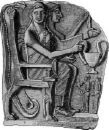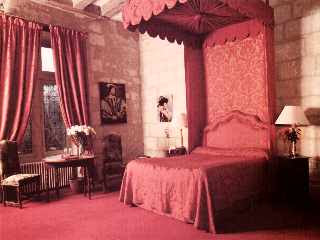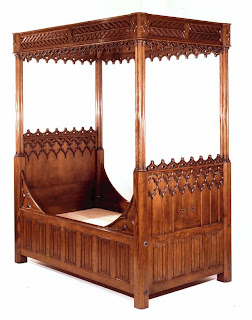
Greek furniture, like Mesopotamian, is best known from paintings and sculpture, as few specimens have survived intact. Details on vase paintings and grave stelae (tombstones) tell a good part of the story, but the frieze from the Parthenon and a group of miniature seated figures in terra-cotta and in bronze help fill in the gaps. A few marble thrones have survived, as have isolated wooden elements from actual Greek pieces. The available evidence suggests that Greek designers did not follow the free forms of the earlier Aegean examples; their tendency to base furniture ornament on architectural decoration, and the general symmetry and regularity of overall design, appear instead to follow Egyptian precedent. Nevertheless, although they resemble each other, the Greek couch and the Egyptian bed, for example, serve markedly distinct purposes. Used for eating as well as resting, the Greek couch was made with the horizontal reclining area at table height, rather than low and at an incline. The headrest was often curved to support pillows and no foot rest was used. Although the animal-form leg is seen occasionally, legs more often were a trumpet form or a rectangular design based on a columnar form. Stools were made in a variety of configurations. Folding stools with X-shaped legs and stationary stools with straight legs were made at least from the 6th century bc to the Hellenistic age (323-31 bc).
Both functional and plain examples as well as more elaborate models were created. A distinctive innovation of Greek designers is the chair known as a klismos, a light (or easy) chair with a back. Comfortable and very popular, it was used most in the Archaic and Classical periods (7th century to 4th century bc). The klismos is essentially plain, with legs curving out from the seat and a back support consisting of a simple rectangular panel curved inward from sides to center. Tables pictured in paintings are generally small. Rectangular tops appear to have been the more popular type, with support that consisted most often of three legs—mostly simple and curved but sometimes carved in animal forms—that were at times reinforced with stretchers near the top. Literary references and illustrations suggest that typical tables were light. They were moved in to serve individuals at a dinner and removed after the meal to allow space for entertainers to perform. Round tables of Greek origin were made in the Hellenistic period.
Chests in ancient Greece varied in size from those built on a miniature scale to monumental examples and in design from those with plain flat tops to the more architectural style with gabled lids. They were made variously of wood, bronze, and ivory, with architectural decoration. The traditional configuration of chests is a long-lived phenomenon; it is first found in ancient Egypt and remains evident in 19th-century folk examples. (Source : Encarta)


